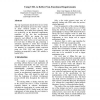Free Online Productivity Tools
i2Speak
i2Symbol
i2OCR
iTex2Img
iWeb2Print
iWeb2Shot
i2Type
iPdf2Split
iPdf2Merge
i2Bopomofo
i2Arabic
i2Style
i2Image
i2PDF
iLatex2Rtf
Sci2ools
CASCON
2001
2001
Using UML to reflect non-functional requirements
The way requirements should drive the rest of the software development process has been a subject of many research projects in the past. Unfortunately, all of them focus primarily, when not exclusively, on the functional requirements regardless of the fact that non-functional requirements (NFR) are among the most expensive and difficult to deal with [6] [13] [4][10]. This work evolves out of a previous one [11] and aims at filling this gap, proposing a systematic approach to assure that conceptual models will reflect the NFRs elicited. We focus our attention on conceptual models expressed using the UML [25], and therefore, some heuristics are proposed to make UML suitable to handle NFRs.
Related Content
| Added | 31 Oct 2010 |
| Updated | 31 Oct 2010 |
| Type | Conference |
| Year | 2001 |
| Where | CASCON |
| Authors | Luiz Marcio Cysneiros, Julio Cesar Sampaio do Prado Leite |
Comments (0)

